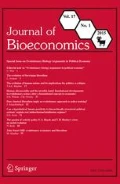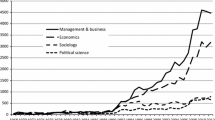Abstract
The theme of this paper is the general population dynamics of evolutionary processes, and, in particular, a number of accounting concepts that are central to any understanding of evolutionary processes of the variation-cum-selection retention kind. A population perspective, for example, turns out to be crucial to the study of the competitive process in economic systems defined at the level of industries, sectors and markets. Business rivalry, underpinned by differential innovative activity, is the basis of the differential survival and growth of competing economic activities and the strategies deployed to create sustainable differences in competitive selection characteristics are at the core of the capitalist dynamic interpreted as an adaptive, evolutionary process. This kind of evolutionary argument is necessarily concerned with growth rate dynamics and the explanation of the diversity of growth rates across entities in a population. However, the following discussion does not provide any causal explanation of economic evolution in terms of the determinants of growth rate differences, rather it provides a bookkeeping scheme in which different causal theories may be set and compared. Growth dynamics and structural change are the two central features of variation/selection processes within populations and I explore them in terms of three themes: namely, Logistic Growth Accounting; Competition Accounting; and, the Price Theorem. The unifying theme that links all three is their relation to the population method in evolutionary theory.
Similar content being viewed by others
References
Alchian A.A. (1950). Uncertainty, evolution and economic theory. Journal of Political Economy 58: 211–221
Andersen, E. S. (2004). Evolutionary econometrics: From Joseph Schumpeter’s failed econometrics to George Price’s general evometrics and beyond. Mimeo. DRUID, Aalborg University.
Ariew A. and Lewontin R.C. (2004). The confusions of fitness. British Journal of Philosophy 55: 347–363
Bailey, M. N., Hulten, C., & Campbell, D. (1992). Productivity dynamics in manufacturing plants. Brookings Papers on Economic Activity: Microeconomics 2.
Bartelsman E.J. and Doms M. (2000). Understanding productivity: Lessons from longitudinal micro datasets. Journal of Economic Literature 38: 569–594
Bouchard F. and Rosenberg A. (2004). Fitness, probability and the principles of natural selection. British Journal of Philosophy 55: 693–712
Brandon R.N. (1991). Adaptation and environment. Princeton University Press, New Jersey
Carlin W., Haskel J. and Seabright P. (2001). Understanding ‘the essential fact about capitalism’: Markets, competition and creative destruction. National Institute Economic Review 175: 67–84
Cohen N.D., Burkhart R., Dosi G., Egidi M., Marengo L., Warglien E. and Winter S.G. (1996). Routines and other recurring action patterns of organizations: Contemporary research issues. Industrial and Corporate Change 5: 653–699
Dawkins R. (1986). The blind watchmaker: Why the evidence of evolution reveals a universe without design. Norton, New York
Dopfer K., Potts J. and Foster J. (2004). Micro-meso-macro. Journal of Evolutionary Economics 14: 263–280
Dosi G. (2000). Innovation, organization and economic dynamics. Edward Elgar, Cheltenham
Downie J. (1958). The competitive process. Duckworth, London
Fisher R.A. (1930). The genetical theory of natural selection. The Clarendon Press, Oxford
Fisher J. and Pry R. (1971). A simple substitution model of technological change. Technological Forecasting and Social Change 3: 75–88
Foss N. and Knudsen C. (1996). Towards a competence theory of the firm. Routledge, London
Foster J. and Metcalfe J.S. (2001). Frontiers of evolutionary economics. Edward Elgar, Cheltenham
Frank S.A. (1998). Foundations of social evolution. Princeton University Press, New Jersey
Gintis H. (2002). Game theory evolving. Princeton University Press, New Jersey
Godfrey-Smith P. (2000). The replicator in retrospect. Biology and Philosophy 15: 403–423
Gould S.J. (2002). The structure of evolutionary theory. Belknap Press, Harvard
Harms W. (1996). Cultural evolution and the variable phenotypes. Biology and Philosophy 11: 357–375
Hodgson G.M. and Knudsen T. (2004). The firm as an interactor: Firms as vehicles for habits and routines. Journal of Evolutionary Economics 14: 281–308
Hodgson, G. M., & Knudsen, T. (2004b). The limits of Lamarkism revisited. Mimeo. University of Hertfordshire, Hatfield.
Horan B.L. (1995). The statistical character of evolutionary theory. Philosophy of Science 61: 76–95
Hull D.L. (1988). Science as a process: An evolutionary account of the social and conceptual development of science. University of Chicago Press, Chicago
Knudsen T. (2004). General selection theory and economic evolution: The price equation and the replicator/interactor distinction. Journal of Economic Methodology 11: 147–173
Knudsen, T. & Hodgson, G. M. (2004). The nature and units of social selection. Paper presented at the workshop: Evolutionary concepts in economics and biology, Jena, December 2005.
Landes D. (1998). The wealth and poverty of nations. Little Brown and Co., London
Laurent J. and Nightingale J. (2001). Darwinism and evolutionary economics. Edward Elgar, Cheltenham
Lewontin R.C. (1974). The genetic basis of evolutionary change. Columbia University Press, New York
Loasby B. (1991). Equilibrium and evolution: An exploration of connecting principles in economics. Manchester University Press, Manchester
Lovas B. and Ghoshal S. (2000). Strategy as guided evolution. Strategic Management Journal 21: 875–896
Marshall A. (1920). Principles of economics. Macmillan, London
Matthen M. and Ariew A. (2002). Two ways of thinking about fitness and natural selection. Journal of Philosophy 99(2): 55–83
Matthen M. and Ariew A. (2005). How to understand causal relations in natural selection: Reply to Rosenberg and Bouchard. Biology and Philosophy 20: 355–364
Mayr, E. (1959). Typological versus population thinking. Reprinted in Mayr, E. (1976). Evolution and the diversity of life: Selected essays. Harvard: Belknap Press.
Metcalfe J.S. (1998). Evolutionary economics and creative destruction. Routledge, London
Metcalfe J.S. (2001). Institutions and progress. Industrial and Corporate Change 10(3): 561–586
Metcalfe J.S. (2006). Entrepreneurship: An evolutionary perspective. In: Casson, M., Yeung, B. and Wadeson, N. (eds) The Oxford handbook of entrepreneurship, pp 59–90. Oxford University Press, Oxford
Metcalfe J.S. and Ramlogan R. (2005). Limits to the economy of knowledge and knowledge of the economy. Futures 37: 655–674
Metcalfe, J. S., & Ramlogan, R. (2006). Creative destruction and the measurement of productivity change. Revue de l’OFCE, June, pp 373–397.
Michod R.E. (1999). Darwinian dynamics. Princeton University Press, New Jersey
Mokyr J. (1990). The lever of riches. Oxford University Press, Oxford
Mokyr J. (2002). The gifts of Athena. Oxford University Press, Oxford
Montgomery, C. (eds) (1995). Resource-based and evolutionary theories of the firm. Kluwer Academic Publishers, Dordrecht
Nanay B. (2002). The return of the replicator: What is philosophically significant in a general account of replication and selection. Biology and Philosophy 17: 109–121
Nelson R. and Winter S.G. (1982). An evolutionary theory of economic change. Belknap Press, Harvard
Nelson R. and Winter S.G. (2002). Evolutionary theorising in economics. Journal of Economic Perspectives 16: 23–46
Nightingale J. (1998). Jack Downie’s ‘competitive process: The first articulated population model in economics’. History of Political Economy 30: 369–408
Okashi S. (2004a). Multi-level selection and the partitioning of covariance: A comparison of three approaches. Evolution 58(3): 486–494
Okashi S. (2004b). Multi-level selection, covariance and contextual analysis. British Journal of Philosophy 55: 481–504
Page K.M. and Nowack M.A. (2002). Unifying evolutionary dynamics. Journal of Theoretical Biology 219: 93–98
Price G.R. (1970). Selection and covariance. Nature 227: 520–521
Sober E. (1984). The nature of selection. MIT Press, Boston
Sober E. and Wilson D.S. (1998). Unto others: The evolution and psychology of unselfish behavior. Harvard University Press, Cambridge, MA
Sterelny K., Smith K.C. and Dickison M. (1996). The extended replicator. Biology and Philosophy 11: 377–403
Tuomi J. (1992). Evolutionary synthesis: A search for the strategy. Philosophy of Science 59: 429–438
Vrba E.S. and Gould S.J. (1986). The hierarchical expansion of sorting and selection: Sorting and selection cannot be equated. Paleobiology 12: 217–228
Walsh D.M. (2003). Fit and diversity: Explaining adaptive evolution. Philosophy of Science 70: 280–301
Winter S.G. (1963). Economic “natural selection” and the theory of the firm. Yale Economic Essays 4(1): 225–272
Witt U. (2003). The evolving economy. Edward Elgar, Cheltenham
Author information
Authors and Affiliations
Corresponding author
Rights and permissions
About this article
Cite this article
Metcalfe, J.S. Accounting for economic evolution: Fitness and the population method. J Bioecon 10, 23–49 (2008). https://doi.org/10.1007/s10818-008-9029-6
Published:
Issue Date:
DOI: https://doi.org/10.1007/s10818-008-9029-6




